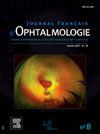Birdshot Chorioretinite总ERG的变化与OCT中心黄斑厚度的相关性
IF 1.1
4区 医学
Q3 OPHTHALMOLOGY
引用次数: 0
摘要
目的描述不同阶段Birdshot脉络膜炎(BSCR)患者的电镜(ERG)特征,并评估ERG异常与光学相干断层扫描(OCT)测量的中央黄斑厚度之间的相关性。一项回顾性20只眼睛的研究,10例患者同时接受ISCEV GERG和黄斑中心黄斑厚度(CMT) CT。5只眼睛的ERG无法分辨。在其他15只眼睛中,我们发现了以下异常:scotopic b (DA 0.01, DA 3.0和DA 10.0)和光波(LA 3.0)振幅下降,光波b的隐式时间增加(LA 3.0)和振荡电位改变。经年龄和性别调整后,OCT测量的CMT与LA 3.0处b波的隐式时间相关(- 0.862;p = 0.08)和闪烁周期30hz (- 0.883;P = 0.08)。ERG的scotopic参数与CMT无关。视网膜电发生在BSCR中发生了改变。根据我们的研究结果,中心黄斑厚度与30hz闪烁周期和DA 3.0 b波的隐式时间之间存在相关性。因此,OCT可以作为RCB进行性病变的证据,可以作为ERG的补充分析检查。目的:描述一系列鸟射脉络膜性脉络膜病(BSCR)患者不同阶段的电视网膜图(ERGs)特征,并评估ERG异常与光学相干断层扫描(OCT)测量的中央黄斑厚度之间的相关性。这是一项回顾性研究,根据国际视觉临床电生理学学会(ISCEV)方案和同时进行黄斑中心厚度测量(CMT)的黄斑OCT,对10名同时进行全球ERG的患者进行了20只眼睛。结果5只眼睛有无法识别的ERG。在其他15只眼睛中,发现了以下异常:scotopic (DA 0.01, DA 3.0, DA 10.0)和光光(LA 3.0) b波的振幅下降,光光b波的隐式时间增加(LA 3.0),以及振荡电位的变化。经年龄和性别调整后,OCT测量的CMT与LA 3.0处b波的隐式时间相关(- 0.862;P = 0.08)和闪烁30Hz周期(- 0.883;P = 0.08)。没有scotopic ERG参数与CMT相关。BSCR的视网膜电发生发生改变。我们的研究表明,中心黄斑厚度与闪烁30hz周期和DA 3.0时b波的隐式时间之间存在相关性。因此,OCT可以反映BSCR的逐步参与,可以是对ERG的补充检查。本文章由计算机程序翻译,如有差异,请以英文原文为准。
Modifications de l’ERG global dans la choriorétinite de Birdshot et corrélation à l’épaisseur maculaire centrale en OCT
Objectif
Décrire les caractéristiques des électrorétinogrammes (ERG) d’une série de patients atteints d’une choriorétinite de Birdshot (BSCR) à des stades différents et évaluer l’existence d’une corrélation entre les anomalies de l’ERG et l’épaisseur maculaire centrale mesurée en Optical Coherence Tomography (OCT).
Matériel et méthode
Étude rétrospective sur 20 yeux de 10 patients ayant bénéficié à la fois et de façon concomitante d’un ERG global selon le protocole ISCEV et d’un OCT maculaire, avec mesure de l’épaisseur maculaire centrale central macular thickness (CMT).
Résultats
Cinq yeux avaient un ERG non discernable. Dans les quinze autres yeux on retrouvait les anomalies suivantes : diminution de l’amplitude de l’onde b scotopique (DA 0.01, DA 3.0 et DA 10.0) et photopique (LA 3.0), augmentation du temps implicite de l’onde b photopique (LA 3.0) et altérations des potentiels oscillatoires. Après ajustement sur l’âge et le sexe, la CMT mesurée par l’OCT était corrélée aux temps implicites de l’onde b au LA 3.0 (–0,862 ; p = 0,08) et à la période du Flicker 30 Hz (–0,883 ; p = 0,08). Aucun paramètre scotopique de l’ERG n’était corrélé à la CMT.
Conclusion
L’électrogenèse rétinienne est altérée dans la BSCR. Il existe une corrélation entre l’épaisseur maculaire centrale et la période du Flicker 30 Hz et le temps implicite de l’onde b au DA 3.0 d’après les résultats de notre étude. L’OCT peut donc témoigner de l’atteinte évolutive de la BSCR et peut être un examen d’analyse complémentaire de l’ERG.
Purpose
To describe the characteristics of electroretinograms (ERGs) of a series of patients with Birdshot Chorioretinopathy (BSCR) at various stages and evaluate the correlation between ERG abnormalities and central macular thickness measured on Optical Coherence Tomography (OCT).
Materials and methods
This was a retrospective study of 20 eyes of 10 patients who underwent both a global ERG according to the International society for clinical electrophysiology of vision (ISCEV) protocol and simultaneous macular OCT with measurement of central macular thickness (CMT).
Results
Five eyes had non-discernible ERGs. In the other fifteen eyes, the following abnormalities were found: decreased amplitude of the scotopic (DA 0.01, DA 3.0, and DA 10.0) and photopic (LA 3.0) b-waves, increased implicit time of photopic b-wave (LA 3.0), and changes in oscillatory potentials. After adjusting for age and gender, CMT measured by OCT was correlated with implicit times of the b-wave at LA 3.0 (–0.862; P = 0.08) and Flicker 30 Hz period (–0.883; P = 0.08). No scotopic ERG parameter was correlated with CMT.
Conclusion
Retinal electrogenesis is altered in BSCR. There is a correlation between central macular thickness and Flicker 30 Hz period and implicit time of b-wave at DA 3.0, as demonstrated by our study. Therefore, OCT can reflect progressive involvement in BSCR and can be a complementary examination to ERG.
求助全文
通过发布文献求助,成功后即可免费获取论文全文。
去求助
来源期刊
CiteScore
1.10
自引率
8.30%
发文量
317
审稿时长
49 days
期刊介绍:
The Journal français d''ophtalmologie, official publication of the French Society of Ophthalmology, serves the French Speaking Community by publishing excellent research articles, communications of the French Society of Ophthalmology, in-depth reviews, position papers, letters received by the editor and a rich image bank in each issue. The scientific quality is guaranteed through unbiased peer-review, and the journal is member of the Committee of Publication Ethics (COPE). The editors strongly discourage editorial misconduct and in particular if duplicative text from published sources is identified without proper citation, the submission will not be considered for peer review and returned to the authors or immediately rejected.

 求助内容:
求助内容: 应助结果提醒方式:
应助结果提醒方式:


